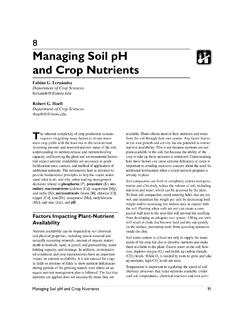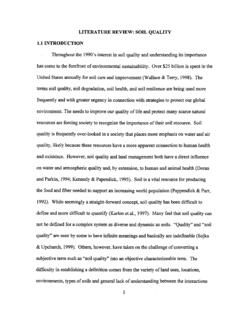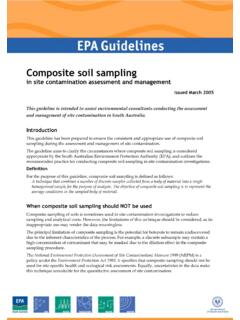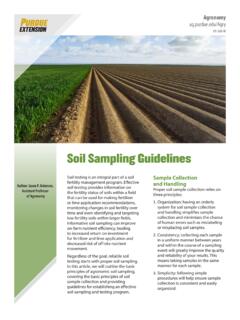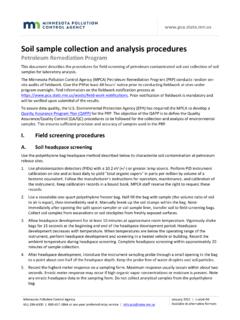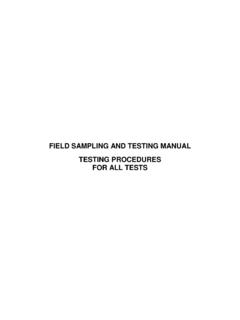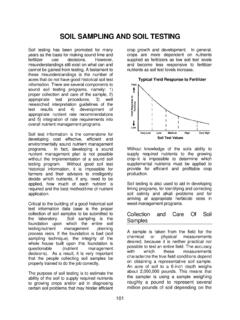Transcription of The Importance of Sampling Soil
1 Information sheets are essential. Often, laboratories have information sheets The Importance of Sampling soil available and will send them upon request. A soil test is essential to determine soil This publication summarizes: fertility levels and make good nutrient Field area to sample Sampling process When marking the soil sample bag for United States Department of Agriculture management decisions. Appropriate nutrient Time of Sampling Drying samples identification, make sure the label correctly Natural Resources Conservation Service application can increase yields, reduce Sampling tools Sample and corresponds to the information sheet.
2 Production costs, and prevent surface and Sampling depth shipping Place the information sheet along with the groundwater pollution. Amount of sample bagged samples in a sturdy cardboard box Sampling Soils for or similar container for shipment to the laboratory. If shipping frozen samples, seal Nutrient Management General Sampling Procedures the information sheet in a plastic bag. A critical step in obtaining accurate soil tests is collecting representative samples in the field. Manure as a Resource Series For More Information Typically, uniform fields should be sampled in a simple random pattern across the field collecting at least 15-20 equal size soil cores.
3 Avoid, or sample separately, areas like abandoned farmsteads For soil Sampling information or assistance, and feedlots, manure piles, fences, roads, eroded knolls, low areas, and salty or wet spots. contact your local Natural Resources Fields with significant landscape or other differences should be divided into separate sample Conservation Service (NRCS), conservation areas. Differences may district, or Extension Service office. include soil types, USDA - NRCS slope, degree of erosion, 10 East Babcock Street drainage, crop and/or Federal Building Room 443 manure history, or other Bozeman, MT 59715 factors that may influence 406-587-6837 soil nutrient levels.
4 11. More intensive Sampling Manure as a Resource should be used where Series detailed information about within field nutrient Three additional brochures are in this series. variability is needed ( To receive a copy of any of the following precision application brochures, visit your local NRCS office or techniques and zone development). Calibrating Manure Spreader Application Rates soil Sampling Process Using Manure Analysis Results Careful soil Sampling and sample handling is essential for accurate fertility recommendations. Sampling Soils for Nutrient Management Samples must accurately reflect the fertility of the soil so that analysis, interpretations, and recommendations correctly represent the nutrient status of the entire field.
5 Accurate evaluation can result in more efficient fertilizer use, reduced costs, and reduced environmental degradation. Field Area Helping People Help the Land A composite soil sample should represent a uniform field area. Each area should have a similar USDA is an equal opportunity provider and employer. MT 04/07 crop and fertility history. soil characteristics (color, slope, texture, drainage) should be similar. Exclude small areas within a field that are markers for identifying samples on sample Approximately a pint (two cups) of the soil the surface and subsurface samples.
6 Obviously different. These can be sampled bags. Tools should be clean, free of rust, and mixture (called the composite sample) is then Mix, dry, and bag each portion separately. separately if they are large enough to warrant stored away from fertilizer materials. DO NOT placed in a soil sample bag which is often lined treatment. The field area represented by a USE galvanized or brass equipment of any with plastic. Montana State University fertilizer guidelines single composite sample should represent no kind as it will contaminate the samples with for nitrate-nitrogen are based on soil analysis soil Profile to two feet.
7 In cases where a field is higher more than 40 irrigated acres or 100 dryland micronutrients. acres. Fewer acres is better. variable or vulnerable to leaching, collecting Sampling Depth additional samples to a depth of 24 to 48. Time of Sampling Laboratory tests are calibrated to specific depths. inches is recommended. Collect soil samples from fields used for crop It is vital to collect samples from appropriate 0'. production after harvest and before planting depths because a core taken deeper or shallower Sample 0-6 . the subsequent crop. To obtain the most will generate erroneous results.
8 Sampling depth for nitrate-nitrogen, accurate estimates of nitrogen availability, for most soils is typically the tillage depth in organic matter, take samples as close to planting time as six-inch intervals. The top six inches of soil has phosphorus, possible. Sampling fields near the same time the most root activity and fertilizer applications potassium, pH, and each year is recommended for more consistent are generally restricted to this depth. These soluble salts. results. Nitrate-nitrogen concentrations should surface soil samples (zero to six inches) are be determined annually for non-legume crops.
9 Typically used for conventional tests of organic Phosphorus and potassium determinations matter, phosphorus, potassium, pH, and salt should be made every three to four years. levels. Deep-rooted crops such as wheat and Sampling and testing for both phosphorus barley need deeper samples if nitrogen fertilizer 1' Take a full 24-inch Place the two Bag the dry and nitrate-nitrogen is required prior to recommendations are desired. Be sure to soil core sample in portions of the surface and manure application. Beware of situations separate and discard surface litter.
10 Many field locations. core in separate subsurface that may cause soil values to change between Subsoil samples from the six- to 24-inch depth plastic buckets. samples. Sampling and planting, heavy rainfall or preirrigation on sandy soils could leach are needed to estimate available nitrogen and in Drying samples some cases sulfur. Nitrate-nitrogen and sulfate- nitrate-nitrogen from the root zone. Moist soil samples must be air dried as soon sulfur are mobile in the soil and will move as possible before being bagged and sent to a Sampling Tools below the six-inch tillage layer.










